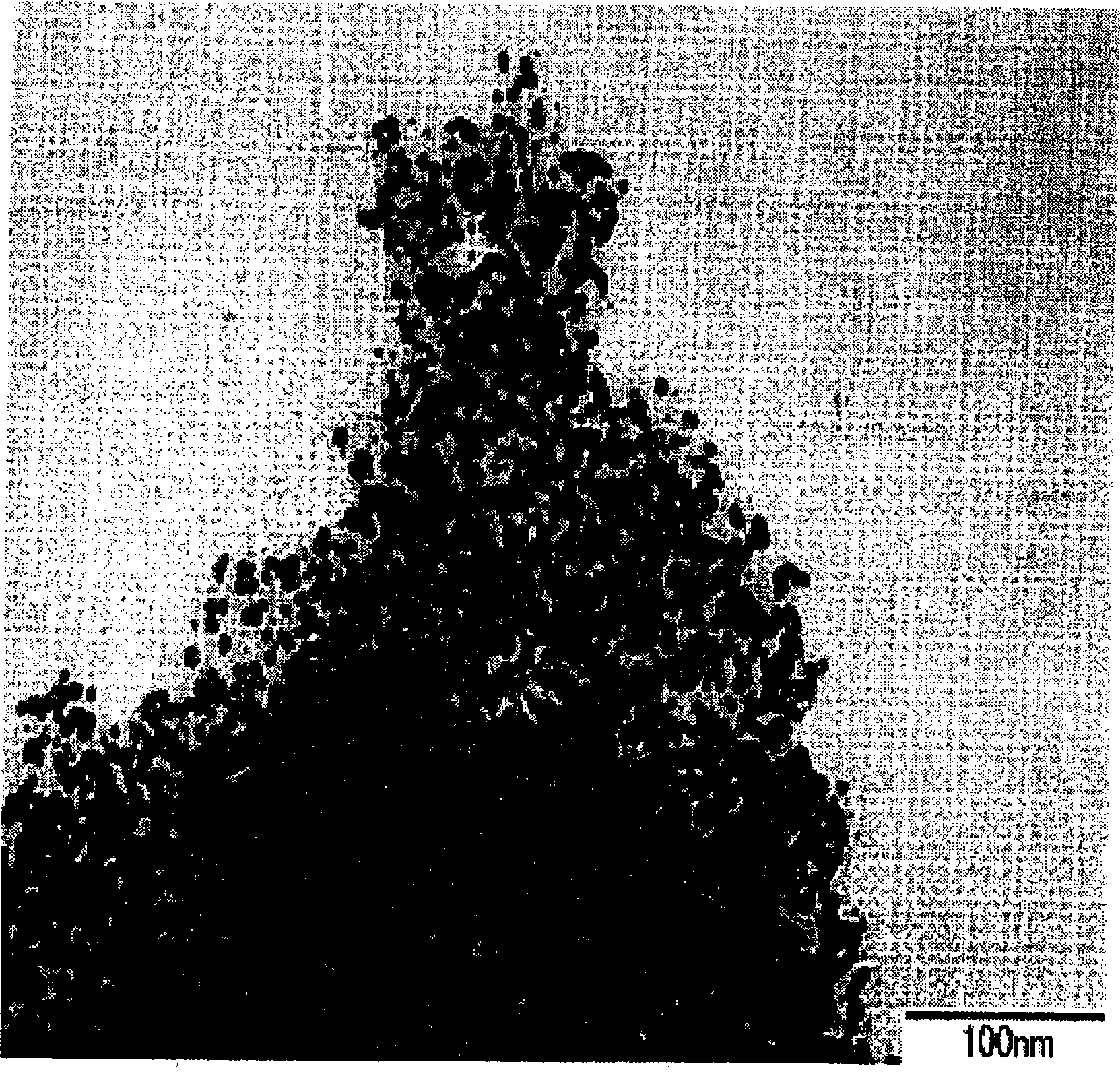Metal nanoparticle dispersion and process for producing the same
A metal nanoparticle, manufacturing method technology, applied in nanotechnology, nanotechnology, nanotechnology for materials and surface science, etc., can solve problems such as insufficient dispersion stability, achieve excellent self-organization ability, effective specific surface area, The effect of high surface energy
- Summary
- Abstract
- Description
- Claims
- Application Information
AI Technical Summary
Problems solved by technology
Method used
Image
Examples
Embodiment
[0102] Hereinafter, the present invention will be described in more detail by citing examples, but the present invention is not limited to these examples. In addition, "%" means "mass %" unless otherwise specified.
[0103] In addition, molecular structures and substance names are indicated in the following abbreviated forms.
[0104] PEI: Polyethyleneimine
[0105] PEG: polyethylene glycol
[0106] PEGM: polyethylene glycol monomethyl ether
[0107] PAEI: polyacetylethyleneimine
[0108] PBEI: Polybenzoylethyleneimine
[0109] PPEI: Polypropionylethyleneimine
[0110] PVAC: polyvinyl acetate
[0111] PVAL: polyvinyl alcohol
[0112] EP: epoxy resin
[0113] BisAEP: bisphenol A epoxy resin
[0114] PSt: polystyrene
[0115] PMMA: polymethyl methacrylate
[0116] MOZ: 2-Methyloxazoline
[0117] EOZ: 2-Ethyloxazoline
[0118] POZ: 2-Phenyloxazoline
[0119] DMA: N,N-Dimethylacetamide
[0120] In the following examples, the machine type used
[0121] 1 H-NMR: man...
Synthetic example 1
[0128] Synthesis Example 1 Synthesis of Polymer Compound (X-1) with PEG-Linear PEI-PBEI Structure
[0129] 1-1[Tosylation reaction of polyethylene glycol]
[0130] In a solution mixed with 10 g (5.1 mmol) of PEGM [the number average molecular weight (Mn) was 2000], 15 g of chloroform and 4 g (51 mmol) of pyridine, was added the solution obtained by dissolving 4.9 g (25.5 mmol) of toluenesulfonyl chloride in 15 g of chloroform. solution, and reacted at 40°C for 4 hours. After the reaction finished, add 30g chloroform to dilute, and wash 2 times with 300g 2.5mol / L hydrochloric acid, wash 2 times with 300g 10% sodium bicarbonate aqueous solution, then wash 2 times with 300g water. The resulting chloroform solution was dried over sodium sulfate, filtered, and then concentrated with an evaporator. It was added to hexane with stirring, precipitated, and vacuum-dried. The yield was 81%. Depend on 1 H-NMR spectrum determines the attribution of each peak (2.4ppm: the methyl group ...
Synthetic example 2
[0140] Synthesis Example 2 Synthesis of Polymer Compound (X-2) with PEG-PEI-BisAEP Structure
[0141] 2-1[Tosylation reaction of EP]
[0142] In a solution mixed with 2g of bisphenol A type epoxy resin EPICLON AM-040-P (manufactured by Dainippon Ink Chemical Industry Co., Ltd.) (epoxy group: 7.9mmol), 10g of chloroform and 6.2g (79mmol) of pyridine, add A solution obtained by dissolving 7.5 g (39.5 mmol) of toluenesulfonyl chloride in 15 g of chloroform was then reacted at 40° C. for 4 hours. After the reaction finished, add 20g chloroform to dilute, and wash twice with 100g 2.5mol / L hydrochloric acid, wash twice with 100g 10% sodium bicarbonate aqueous solution, then wash twice with 100g water. The resulting chloroform solution was dried over sodium sulfate, filtered, and then concentrated with an evaporator. This was added to hexane, precipitated, and dried in vacuo. The yield was 91%. Depend on 1 H-NMR spectrum determines the attribution of each peak (1.6ppm: the methy...
PUM
| Property | Measurement | Unit |
|---|---|---|
| particle diameter | aaaaa | aaaaa |
| particle diameter | aaaaa | aaaaa |
| particle size | aaaaa | aaaaa |
Abstract
Description
Claims
Application Information
 Login to View More
Login to View More - R&D
- Intellectual Property
- Life Sciences
- Materials
- Tech Scout
- Unparalleled Data Quality
- Higher Quality Content
- 60% Fewer Hallucinations
Browse by: Latest US Patents, China's latest patents, Technical Efficacy Thesaurus, Application Domain, Technology Topic, Popular Technical Reports.
© 2025 PatSnap. All rights reserved.Legal|Privacy policy|Modern Slavery Act Transparency Statement|Sitemap|About US| Contact US: help@patsnap.com


